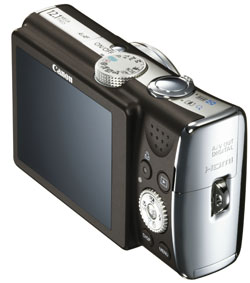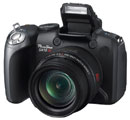Canon PowerShot SX200 IS
-
-
Written by Gordon Laing
Canon PowerShot SX200 IS verdict
Canon’s PowerShot SX200 IS is the company’s first attempt at creating a pocket-sized super-zoom camera, and it’s certainly hit the ground running. With the SX200 IS you get the flexibility of a 12x optically-stabilised zoom, automatic scene detection or full manual control over the aperture and shutter, a 3in screen, HD movies and an HDMI port, all packed into a small and discreet body. It may be a little too chunky to squeeze into the smallest pockets, but it’ll easily slip into bags or larger pockets and never be a burden.
That’s the dream of the pocket super-zoom camera: small enough to take anywhere, but sporting an impressive zoom range that covers almost every conceivable situation, from wide-angle panoramas to serious telephoto close-ups.
The PowerShot certainly delivers such a zoom range, starting at 28mm for decent wide-angle coverage, and not stopping until an equivalent of 336mm at the telephoto end. In practice you could be shooting a big landscape or building, before then zooming-in on distant detail seconds later. It gives you amazing flexibility considering the size of the camera.
Canon’s unsurprisingly taken a very close look at the leader (and almost exclusive player) in this market, Panasonic’s Lumix TZ series, and also equipped the SX200 IS with a 3in screen along with HD movies in the 720p format. Canon also spotted an opportunity where it could take a lead over Panasonic by additionally offering full manual control over the aperture and shutter, while Panasonic’s TZ series remains fully automatic. Finally, in the resolution numbers-game, Canon’s SX200 IS takes the lead over the latest Panasonic TZ7 / ZS3 with an extra two Megapixels.
So while both the SX200 IS and Lumix TZ7 / ZS3 can claim 12x optical zooms, 3in screens, HD movies and HDMI ports, Canon can boast two extra Megapixels and the benefit of manual controls for pretty much the same price. In these terms it looks like Canon has a winner on its first attempt, but as always it’s crucial to look a little deeper.
In our tests, there wasn’t any significant benefit to the extra Megapixels over Panasonic’s model, and the Lumix TZ7 / ZS3 managed to look preferable in some instances due to its in-camera correction of coloured fringing. To be fair, the fringing isn’t that bad on the Canon, but it is there on some shots, while it’s essentially invisible on the Panasonic. By packing 2 million extra photosites on the same sized sensor, the SX200 IS also suffered at higher sensitivities to a slightly greater degree than the TZ7 / ZS3, or indeed Canon’s own 10 Megapixel models. But like most compacts, none look great above 200 ISO – see our results pages for a full report.
Both cameras may feature 12x zoom ranges, but the Panasonic’s starts a little wider at 25mm, and that’s arguably more useful than the slightly longer telephoto reach of the Canon.
 |
The HD movie mode on the SX200 IS can deliver some good looking results, but like the IXUS 100 IS / SD780 IS, often has a subdued appearance compared to many. More importantly, and a deal-breaker for a lot of photographers, is the inability to optically zoom while filming. The TZ7 / ZS3 can zoom during videos (albeit with some focusing issues), while also offering stereo sound and more encoding options.
Moving onto the screen, the SX200 IS’s 3in model looks good, but Panasonic’s version is more detailed and in our tests was more visible under direct sunlight while also offering a live histogram option. Panasonic also offers faster continuous shooting options if you’re willing to reduce the resolution or buffer, along with a longer 60 second maximum exposure.
The SX200 IS’s body is also thicker than the TZ7 / ZS3, doesn’t have an optional underwater housing, and annoyingly raises its flash as you power the camera-up. This longer subsequent flash to lens distance may slightly decrease red-eye, but it’s annoying to have your left fingers prodded by the flash when powering-up the camera while holding it with both hands.
The Canon does have one major advantage over the Panasonic though: full manual control over exposure. This will undoubtedly be a key selling-point for enthusiasts and it certainly allows you to manually adjust the aperture and shutter, but as described in the main review, it’s important to take a reality check. Having aperture priority doesn’t guarantee the ability to achieve a small depth-of-field; indeed like most compacts, the SX200 IS has an inherently large depth-of-field, making it impossible to achieve very blurred backgrounds on portraits, even with the aperture wide open. On the plus side though, having shutter priority does allow you to choose, say, slower exposures to deliberately blur action which is great for waterfalls or panning effects. So having manual controls is genuinely useful, but it’s important to understand the limitations.
So before wrapping-up, how does the SX200 IS compare against its arch rival, the Panasonic Lumix TZ7 / ZS3, along with Canon’s own larger super-zoom, the PowerShot SX10 IS?
Compared to Panasonic Lumix DMC-TZ7 / ZS3
 |
Panasonic arguably invented the pocket super-zoom category with its enormously successful TZ series, and the company’s latest TZ7 / ZS3 is the model Canon’s directly targeting with the SX200 IS. Both cameras have a great deal in common, including 12x zooms, 3in screens, automatic scene detection, HD video recording in the 720p format and HDMI ports for connecting to an HDTV. They’re also roughly the same size, weight and price. But look a little closer and there’s actually considerable differences.
In its favour, the Lumix TZ7 / ZS3 has a wider zoom range of 25-300mm which is arguably a little more useful than the 28-336mm of the Canon. More importantly, it can optically zoom while filming video (unforgivably absent on the SX200 IS), offers a choice of encoding options for longer recording times or easier editing, and records stereo sound. Both screens may be 3in in size, but the TZ7 / ZS3’s boasts double the total pixels for much more detailed playback, along with a live histogram option. The TZ7 / ZS3 may not have a face-based self-timer or blink detection, but it can recognise and store a handful of faces for priority focusing, and there’s a burst mode which may greatly reduce the quality, but can shoot at up to 10fps. Finally, the body is also 5mm thinner, the flash doesn’t annoyingly popup, and there’s an optional underwater housing.
In its favour, the PowerShot SX200 IS sports far greater manual exposure control with Program, Aperture, Shutter Priority and full Manual modes in addition to the usual Auto and Scene preset options. It features two additional Megapixels, a higher bit-rate in its movie mode and a neat self timer mode which exploits face detection to wait until the photographer enters the frame before taking the shot, not to mention blink detection which can warn you if a subject has their eyes closed in a photo. And while the lens doesn’t zoom quite as wide, it does zoom a little closer.
In our tests the SX200 IS’s higher resolution didn’t give it a significant edge over the TZ7 / ZS3 and in some cases the image quality of the Panasonic was preferred, especially in terms of digital reduction of coloured fringing. Ultimately the decision boils down to comparing which feature-set best suits your requirements, but while the manual exposure control on the Canon is certainly nice to have, the Panasonic is simply much better-featured overall. Most would happily sacrifice manual control for a wider lens, more detailed screen, faster continuous shooting and the ability to zoom while filming. See our Panasonic Lumix DMC-TZ7 / ZS3 review for more details.
Compared to Canon PowerShot SX10 IS
 |
Canon’s PowerShot SX10 IS may be a completely different form-factor to the SX200 IS, but as a super-zoom which costs roughly the same, it’s important to compare their features. In its favour, the PowerShot SX10 IS has a much longer 20x zoom (28-560mm vs 28-336mm), can optically zoom while filming, has a fully-articulated screen (albeit smaller at 2.5in), stereo sound for movies, a flash hotshoe and a larger, more comfortable grip. Some may also prefer the flexibility of AA battery operation.
In its favour the PowerShot SX200 IS is obviously considerably smaller and lighter, has two extra Megapixels, a larger 3in screen (although the same resolution), automatic scene detection, and HD movie recording in the 720p format with an HDMI port for connecting to HDTVs.
In our tests the higher resolution didn’t give the SX200 IS any real benefit, and in some results, the SX10 IS’s images looked better defined. So beyond HD movies, HDMI and a bigger screen, the major difference is the form factor. If you want or need a camera which fits in a pocket, then the SX10 IS is immediately eliminated, but if you can accommodate its larger form factor, it represents a compelling alternative to these pocket super-zooms for around the same price. See our PowerShot SX10 IS review and video tour
Also consider:
If your budget is lower and you can live without HD movies and HDMI, Panasonic’s Lumix DMC-TZ6 / ZS1 is an interesting alternative, sharing the same 12x 25-300mm zoom as the TZ7 / ZS3 – we’ve detailed its features in the verdict of our TZ7 / ZS3 review.
 |
While stocks last, it’s also well worth considering the earlier Panasonic Lumix DMC-TZ5, which offers a 10x zoom, 3in / 460k screen and HD movies at a price around one third less than the TZ7 / ZS3 or SX200 IS. See our Panasonic Lumix DMC-TZ5 review for more details.
Canon PowerShot SX200 IS final verdict
As we said at the top of this page, the PowerShot SX200 IS is Canon’s first attempt at a pocket super-zoom, and it’s certainly impressive, packing a 12x zoom, 3in screen, HD movies, an HDMI port and full manual control into a pocketable form factor. Viewed in isolation it’s a highly compelling prospect.
But the big issue facing the SX200 IS is its arch rival, the Panasonic Lumix DMC-TZ7 / ZS3, which lest we forget, has enjoyed several years and generations of evolution and refinement. Considering both cameras share a 12x zoom range, 720p HD movies, HDMI ports, 3in screens and scene detection, not to mention a similar size, weight and price, it’s impressive how quickly Canon has got up to speed on its first generation pocket super-zoom.
But as discussed in detail above, the Lumix TZ7 / ZS3 simply manages to out-feature the SX200 IS in almost every respect. The SX200 IS’s trump card may be manual control over exposures, but the TZ7 / ZS3 boasts a wider lens, more detailed screen, faster continuous shooting and the ability to zoom while filming, along with much more besides. Then there’s that annoying flash on the Canon and its unforgiveable inability to zoom while filming.
Don’t get us wrong though: the PowerShot SX200 IS is an impressive camera with some great features, and fulfils its brief to deliver a flexible super-zoom range with HD movies in a pocketable form-factor. Indeed it’s sufficiently good to easily earn our Recommended award.
But for roughly the same money, Panasonic’s Lumix TZ7 / ZS3 is ultimately more compelling overall. Unless you absolutely need manual control, it remains our top choice in this category, but Panasonic can’t rest on its laurels. Canon’s made a very impressive debut in the pocket super-zoom market and come the next generation the tables could be turned.
Bad points | Scores (relative to 2009 compacts) |
 | ||
Build quality: Image quality: Handling: Specification: Value:
Overall: |
18 / 20 15 / 20 17 / 20 18 / 20 17 / 20
85% | |||



